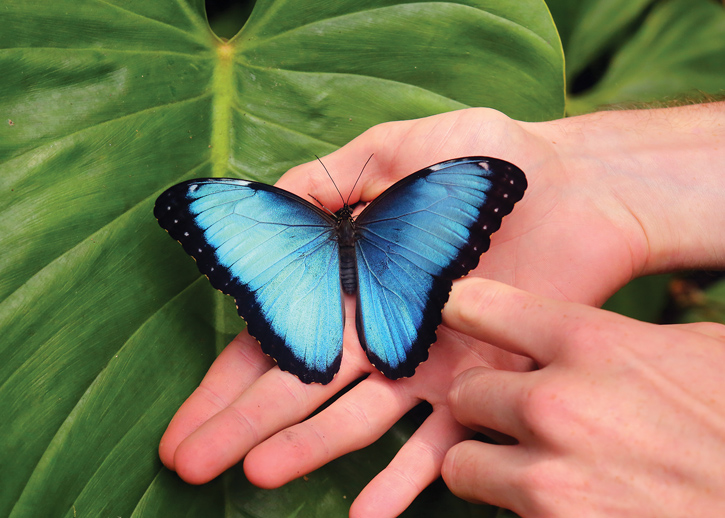With nearly 1,000 identified species (approximately 10 percent of the world total), Costa Rica is a lepidopterist’s paradise. You can barely stand still for one minute without checking off a dozen dazzling species: metallic gold Riodinidae; delicate black-winged Heliconius splashed with bright red and yellow; orange-striped paracaídas; and the deep neon-blue flash of morphos fluttering and diving in a ballet of subaqueous color.
The best time to see butterflies is in the morning, when they are more active, although a few species are more active at dawn and dusk.Some butterflies are ornately colored to keep predators at bay. The bright-white stripes against black on the zebra butterfly (like other members of the heliconia family), for example, tell birds that the butterfly tastes acrid. There are even perfectly tasty butterfly species that mimic the heliconia’s colors, tricking predators into disdain. Others use their colors as camouflage so that at rest they blend in with the green or brown leaves or look like the scaly bark of a tree. Among the most intriguing are the owl-eye butterflies, with their 13-centimeter (5-inch) wingspans and startling eye spots. The blue-gray Caligo memnon, the cream owl butterfly, is the most spectacular of the owl eyes: the undersides of its wings are mottled to look like feathers, and two large yellow-and-black “eyes” on the hind wing, which it displays when disturbed, give it an uncanny appearance of an owl’s face.
The electric blue morphos, the neon narcissi of the butterfly world, make even the most jaded of viewers gape in awe. Photo © Christopher P. Baker.
The Narcissus of the Costa Rican butterfly kingdom is the famous blue morpho. There are about 50 species of morphos, all in Central and South America, where they are called celeste común. The males of most species are bright neon blue, with iridescent wings that flash like mirrors in the sun. This magnificent oversize butterfly grows to 13-20 centimeters (5-8 inches). The morpho is a modest, nondescript brown when sitting quietly with its wings closed. But when a predator gets too close, it flies off, startling its foe with a flash of its beautiful electric-blue wings.
The subspecies differ in color: In the Atlantic lowlands, the morpho is almost completely iridescent blue; one population in the Meseta Central is almost completely brown, with only a faint hint of electric blue. One species, commonly seen gliding around in the forest canopy, is red on the underside and gray on top. Show people have always used mirrors to produce glitter and illusion. The morpho is no exception. Look through a morpho butterfly’s wing toward a strong light and you will see only brown. This is because the scales are brown. The fiery blue is produced by structure, not by pigment. Tiny scales on the upper side of the wing are set in rows that overlap like roof shingles. These scales are ridged with minute layers that, together with the air spaces between them, refract and reflect light beams, absorbing all the colors except blue.
The best time to see butterflies is in the morning, when they are more active, although a few species are more active at dawn and dusk. In general, butterfly populations are densest in June and July, corresponding with the onset of the rainy season on the Pacific side. Like birds, higher-elevation species migrate up and down the mountains with changes in local weather. The most amazing migration—unsurpassed by any other insect in the neotropical region—is that of the black and iridescent green Uraniidae, in which millions of individuals pass through Costa Rica heading south from Honduras to Colombia.
Excerpted from the Tenth Edition of Moon Costa Rica.